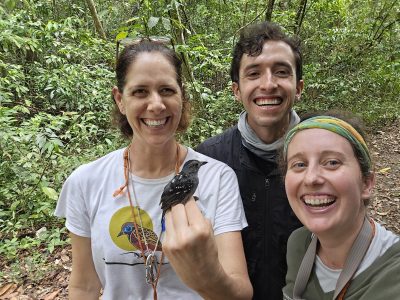For decades, Corey Tarwater and her research team have used mist nets by day to capture various species of tropical birds in Panama to study the effects of global change on bird populations. Now, the University of Wyoming researcher is starting a new collaboration with the Smithsonian Tropical Research Institute (STRI) to use the same mist net lanes to catch bats by night.
“We are really excited to collaborate with the bat team on this project. By working with them, we can figure out whether or not bats are responding the same way to climate that we’re seeing with the birds,” says Tarwater, a UW associate professor in the Department of Zoology and Physiology and the Robert B. Berry Distinguished Chair in Ecology, in an STRI story Friday, April 4. “We are especially interested in whether we see similar responses between bats and birds that eat similar foods. For example, if we see that insectivorous bats are being impacted the most by changes in climate like we see for birds, that adds support to the idea that their prey — the insects — are changing.”

As a somewhat ceremonial first step for this collaboration, Tarwater’s UW bird team met with the STRI’s bat research team, led by Rachel Page, on Soberanía Pipeline Road, a muddy dirt road deep within Panama’s Soberanía National Park. The park is home to approximately 525 bird species, and Pipeline Road extends nearly 11 miles in a north-south direction in the park and passes along the east bank of the Panama Canal through old-growth and secondary tropical forest.
The meeting, which took place March 10, celebrated the launch of a long-term census of bats designed to complement the long-running bird census, which will celebrate its 50th anniversary in 2026.
The new acoustic and mist-netting bat survey will take place twice a year, during the dry and wet seasons, at three sites on Barro Colorado Island, located in the man-made Gatun Lake in the middle of the Panama Canal, and three sites on Pipeline Road. The Pipeline Road sites are in the Limbo plot, which has been used to focus on long-term avian research.
“The goals of this project are to have a long-term collaboration between multiple institutions to ask how birds and bats are responding to global change, to evaluate the underlying mechanisms, and to understand how changes in birds and bats impact ecosystem function,” Tarwater says. “We will do this by conducting mist-netting of birds and bats at the same location and during the same time of year.
“We also will record bird vocalizations and bat echolocation calls to capture the entire community of birds and bats, not just those that fly into our mist nets,” she continues. “We also are collecting similar data when handling the flying animals, including data on morphology, parasites, diet through fecal samples, and genetics.”
“This biannual census will give us the power for all kinds of collaborative comparisons over time,” says Page, STRI staff scientist and director of the Smithsonian Bat Lab, in the STRI story. “We’ll be able to look, year after year, at how changes in the environment and changes in other taxa affect bats — key players in tropical ecosystems.”
The advantage of paired biannual surveys is practical and strategic, say both Tarwater and Page. The bird research team uses mist nets to sample the birds during the day while the bat team can use the same mist net lanes to net bats during the evening. Mist nets are finely woven, large mesh nets erected to entangle and captures birds and bats in flight.
Tarwater says dawn-to-dusk mist-netting for birds in this Panama region began in 1977 by James Karr, a professor emeritus at the University of Washington. Karr’s goal was to ask basic questions about what species of birds would be found in lowland tropical forest. He did mist-netting two times per year, once in the dry season and once in the wet season.
In 1992, Jeff Brawn, a professor emeritus at the University of Illinois, took over the long-term mist-netting, and in 2018, the torch was passed to Tarwater. This is the longest running mist-netting study of birds in the Neotropics, with this being its 49th year, Tarwater says.

“My first year of collecting this data was 2003, as a master’s student of Dr. Brawn, and I have been doing it ever since,” Tarwater says. “I have seen multiple changes just in my time on the bird species that we capture in mist nets.”
While early studies focused on the basic ecology of the bird species, the latest work has focused on the effects of global change on these birds. Recent work has shown that 70 percent of bird species are declining, even in this protected habitat, Tarwater says.
“Further, we have shown that body condition of birds has declined over time and that birds are highly sensitive to changes in rainfall and temperature,” she says. “In particular, we have found that birds that eat insects are the most sensitive to changes in the environment.”
Long-term monitoring is essential for understanding how tropical bird populations are responding to changing environments. Recent studies in tropical forests show that, even in protected habitat, birds are experiencing widespread declines, Tarwater says. Given that birds are critical for pollination, seed dispersal, and insect suppression, these declines raise big concerns for how forests will continue to persist under global change.
Tropical bats have received considerably less attention compared to birds, with long-term monitored efforts lacking, Tarwater says. Nevertheless, tropical bats serve the same ecosystem functions as tropical birds, with bats performing their functions at night while birds perform their functions primarily during the day.
While the bat team has not previously conducted regular monitoring in Panama, Tarwater says that STRI does have a single bat study from the 1990s at the same study site to draw from.
“Our short-term goal is to write a publication focused on how the abundance and diversity of birds and bats has changed between the 1990s and today, and whether we see similar changes between birds and bats that eat similar food items,” Tarwater says. “For example, do we see that insectivorous bats are more sensitive to changes in rainfall like we see in insectivorous birds, compared to other diet guilds? In another 10 years, we can begin to ask questions about how a changing environment influences population growth, recruitment, and survival of bat species, and compare bird and bat responses.”
For a related video, go to the STRI’s Instagram page here.
This story was originally published on UW News.




